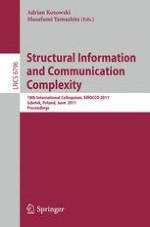2011 | Buch
Structural Information and Communication Complexity
18th International Colloquium, SIROCCO 2011, Gdańsk, Poland, June 26-29, 2011. Proceedings
herausgegeben von: Adrian Kosowski, Masafumi Yamashita
Verlag: Springer Berlin Heidelberg
Buchreihe : Lecture Notes in Computer Science
